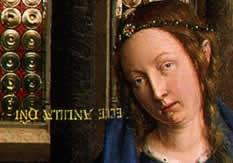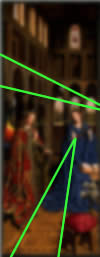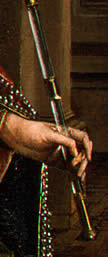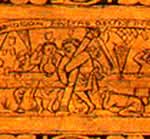Some more details about the Annunciation painting posted last week, which was painted by Jan van Eyck around 1434-36.
 |
||
ECCE ANCILLA D[OMI]NI |
||
|
|
SCENES OF HEROISM The floor has illustrations of one man doing great things (in this case, Sampson destroying the enemies of God) |
|
 |
COMPLEX COMPOSITION The composition uses two perspectives: the foreground objects have a vanishing point somewhere in Mary's abdomen, thus focusing attention on where Jesus is conceived. The other lines have their vanishing point just past the righthand side of the painting. |
|
|
|
THE TRINITY God the Father appears in the stained-glass window at the top, God the Son is in Mary's womb, and God the Holy Spirit is the dove descending on the golden sunbeams. |
|
 |
INTRICATE DETAILS At left, see how the crystal of Gabriel's scepter is translucent, allowing part of his hand and the pillar in the back to be visible. Also, note the light refracted through the circular glass in the topmost picture. |
|
THE MOST ASTONISHING DETAIL The painting is only a little over a foot wide and slightly less than three feet tall. It was the left panel of a triptych, a three-part painting that usually had one central painting in the middle, with two painted panels on the sides that closed to conceal all of the paintings. Typically, a sacred triptych would have been closed except during Mass, at which time it would have been opened while the priest was at the altar. The congregation would have been too far away to see any fine details (though they would have been able to see that it was the Annunciation), and the priest would have been busy praying. This meticulous work -- hours of sketching, layering expensive pigmented oil paints, getting the simulated lighting and skin tones just right -- would have scarcely been seen by anyone except God Almighty. More information about the painting is at the National Gallery of Art. |
||



Thank you Eric for posting this and helping the rest of us see the subtle laudates hidden throughout.
Thanks, Eric. I've recently been more interested in the topic of religious art and have been posting new links to a host of great works of sacred art via Textweek.com over at my site, but nothing like this detail.
I'll pray for you Eric you definately are in need.
Sue
That's an odd comment. Sounds a little smug, even. Why does Sue think Eric's especially in need of prayers?
Does she object to a painting that represents an event described in Scripture?